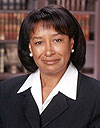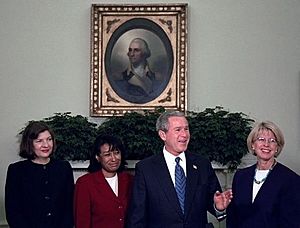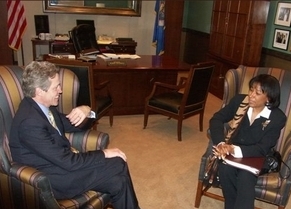Janice Rogers Brown facts for kids
Quick facts for kids
Janice Rogers Brown
|
|
|---|---|

Portrait, c. 2000
|
|
| Judge of the United States Court of Appeals for the District of Columbia Circuit | |
| In office June 10, 2006 – August 31, 2017 |
|
| Appointed by | George W. Bush |
| Preceded by | Stephen F. Williams |
| Succeeded by | Gregory G. Katsas |
| Associate Justice of the California Supreme Court | |
| In office May 3, 1996 – June 10, 2006 |
|
| Appointed by | Pete Wilson |
| Preceded by | Ronald M. George |
| Succeeded by | Carol Corrigan |
| Personal details | |
| Born |
Janice Olivia Allen
May 11, 1949 Greenville, Alabama, U.S. |
| Political party | Republican |
| Spouses |
Alan Brown
(died 1988)Dewey Parker
(m. 1991) |
| Education | |
Janice Rogers Brown (born May 11, 1949) is an American judge. She was a United States circuit judge for the United States Court of Appeals for the District of Columbia Circuit, one of the most important courts in the country. She served from 2006 to 2017.
Before that, she was an Associate Justice of the Supreme Court of California from 1996 to 2006.
In 2003, President George W. Bush chose her to become a judge on the D.C. Circuit court. However, some groups and Democratic senators disagreed with her conservative views. They delayed her approval for almost two years. She was eventually approved in 2005.
A few months later, she was considered for a spot on the Supreme Court of the United States, the highest court in the nation. However, she was not chosen for the position.
Contents
Early Life and Schooling
Janice Olivia Allen was born in Greenville, Alabama, in 1949. Her father was a sharecropper and a World War II veteran. When she was a teenager, she moved to Sacramento, California, with her mother.
Brown earned her first college degree from California State University, Sacramento in 1974. At the time, she was a single mother working at the Department of Corrections. She then went to law school at the University of California, Los Angeles (UCLA), earning her law degree in 1977. She also received an advanced law degree from the University of Virginia School of Law in 2004.
Brown has said that when she was young, her family would not shop at businesses that were segregated by race.
Beginning Her Law Career
For the first 20 years of her career, Brown worked mostly for the government. She held several jobs in California's legal system.
From 1979 to 1987, she was a Deputy Attorney General for California. She also worked for the California Business, Transportation and Housing Agency. For a short time in 1990, she worked at a private law firm.
In 1991, she returned to government to work for California Governor Pete Wilson. She was his Legal Affairs Secretary, giving him advice on laws and court decisions.
California Supreme Court
In 1996, Governor Pete Wilson appointed Brown to be an Associate Justice on the California Supreme Court. This is the highest court in the state of California.
Important Cases
As a justice, Brown wrote the court's official opinion in several important cases.
- In a 2000 case, she wrote an opinion that ended a city program in San Jose that gave special preference to certain groups in city contracts. Her decision supported a California law that banned giving preferential treatment based on race, sex, or ethnicity in public jobs and contracts.
- In another case, she disagreed with the other justices about a law that would have required teenagers to get their parents' permission for certain medical procedures.
- In 2000, she wrote an opinion that allowed the state of California to ban certain types of semi-automatic firearms. She explained that her decision was not about whether the law was a good idea, but about whether the state had the power to make such a law.
U.S. Court of Appeals for the D.C. Circuit
The U.S. Court of Appeals for the D.C. Circuit is a very powerful federal court in Washington, D.C. It often hears cases about the U.S. government's rules and actions.
Nomination and Confirmation


President George W. Bush first nominated Brown to this court in 2003. The process to approve her was long and difficult.
Some civil rights groups and Democratic senators opposed her. They believed she was an "extreme" conservative judge who would let her personal political views affect her decisions. Because of this opposition, the U.S. Senate did not vote on her nomination for nearly two years.
In 2005, President Bush nominated her again. This time, a group of 14 senators from both the Republican and Democratic parties made a deal. This group, known as the Gang of 14, agreed to allow a final vote on Brown and other judges.
On June 8, 2005, the Senate voted to confirm her as a judge on the D.C. Circuit court. The vote was 56 to 43. She officially began her new role on June 10, 2005.
Time on the Court
Just a month after she joined the court, Justice Sandra Day O'Connor retired from the U.S. Supreme Court. Judge Brown was mentioned as a possible replacement, but President Bush chose someone else.
During her time on the D.C. Circuit, Brown was known for her strong opinions. In one case, she disagreed with the other judges who had stopped the U.S. military from moving a prisoner. Brown wrote that the court was interfering with the power of the President and the military.
Judge Brown retired from the U.S. Court of Appeals on August 31, 2017.
Life After Retirement
After retiring as a judge, Janice Rogers Brown has continued to be involved in law and education.
In 2019, she taught a class at the University of California Berkeley School of Law. As of 2022, the university still listed her as a lecturer.
She has also served on the boards of Pepperdine University and the University of the Pacific.
Personal Life
Janice Rogers Brown had one son, Nathan, with her first husband, Allen E. Brown Sr. He passed away in 1988. Three years later, she married Dewey Parker, a jazz musician.
See also
- List of African-American federal judges
- List of African-American jurists
- List of first women lawyers and judges in California
- List of justices of the Supreme Court of California
- George W. Bush judicial appointment controversies
- George W. Bush Supreme Court candidates
- Gang of 14
- Black conservatism in the United States
Videos
- Video of Judge Brown's Investiture

